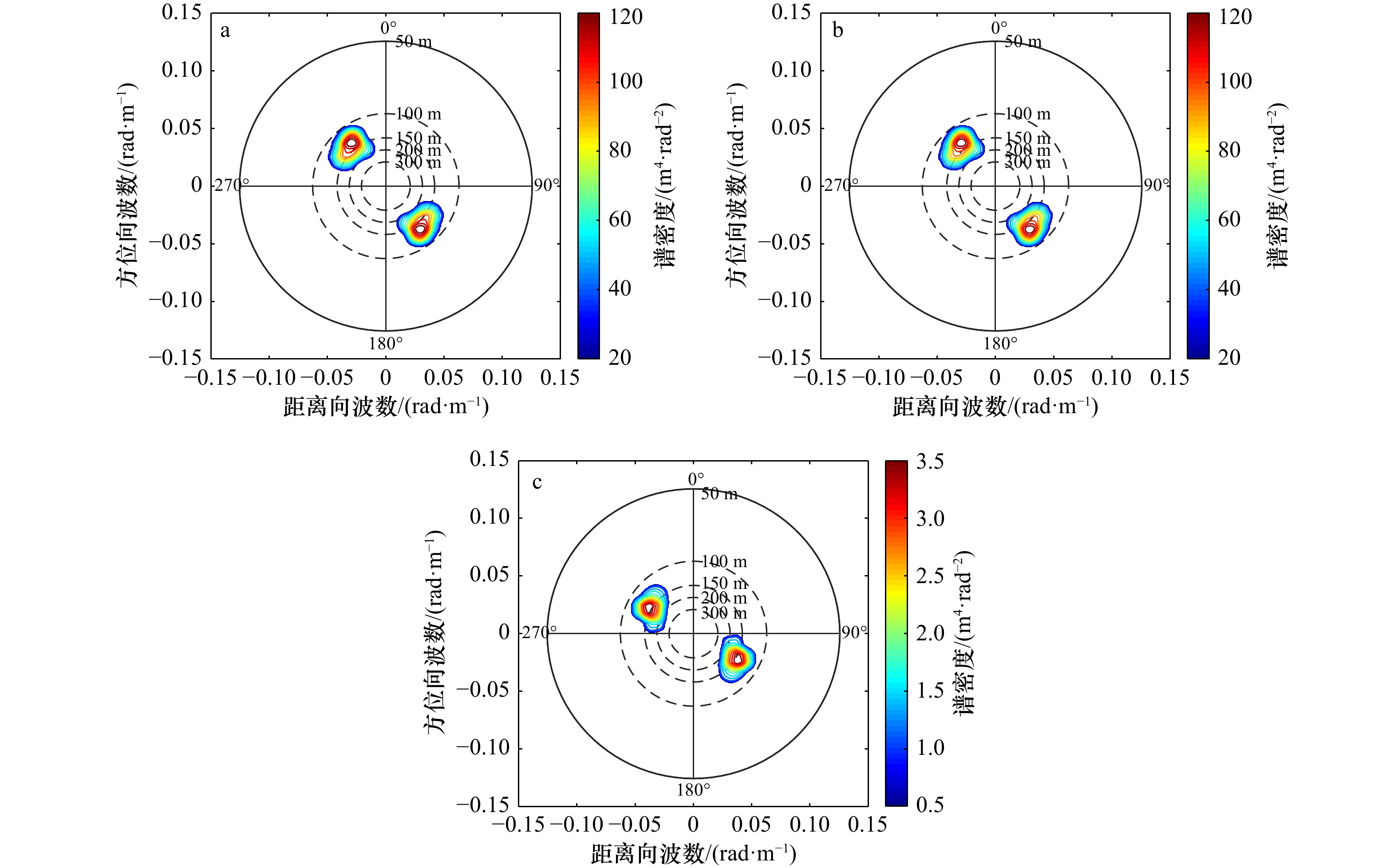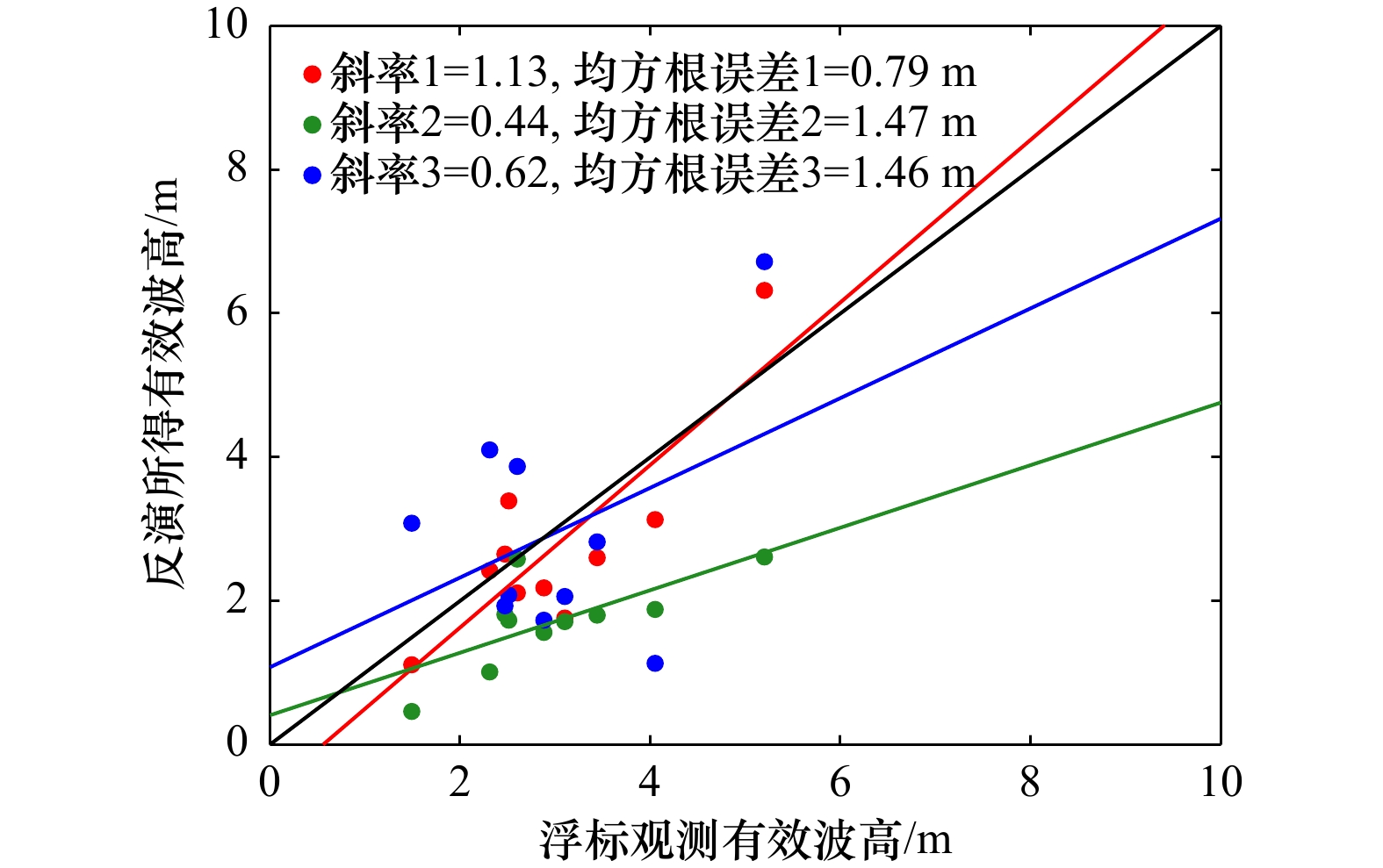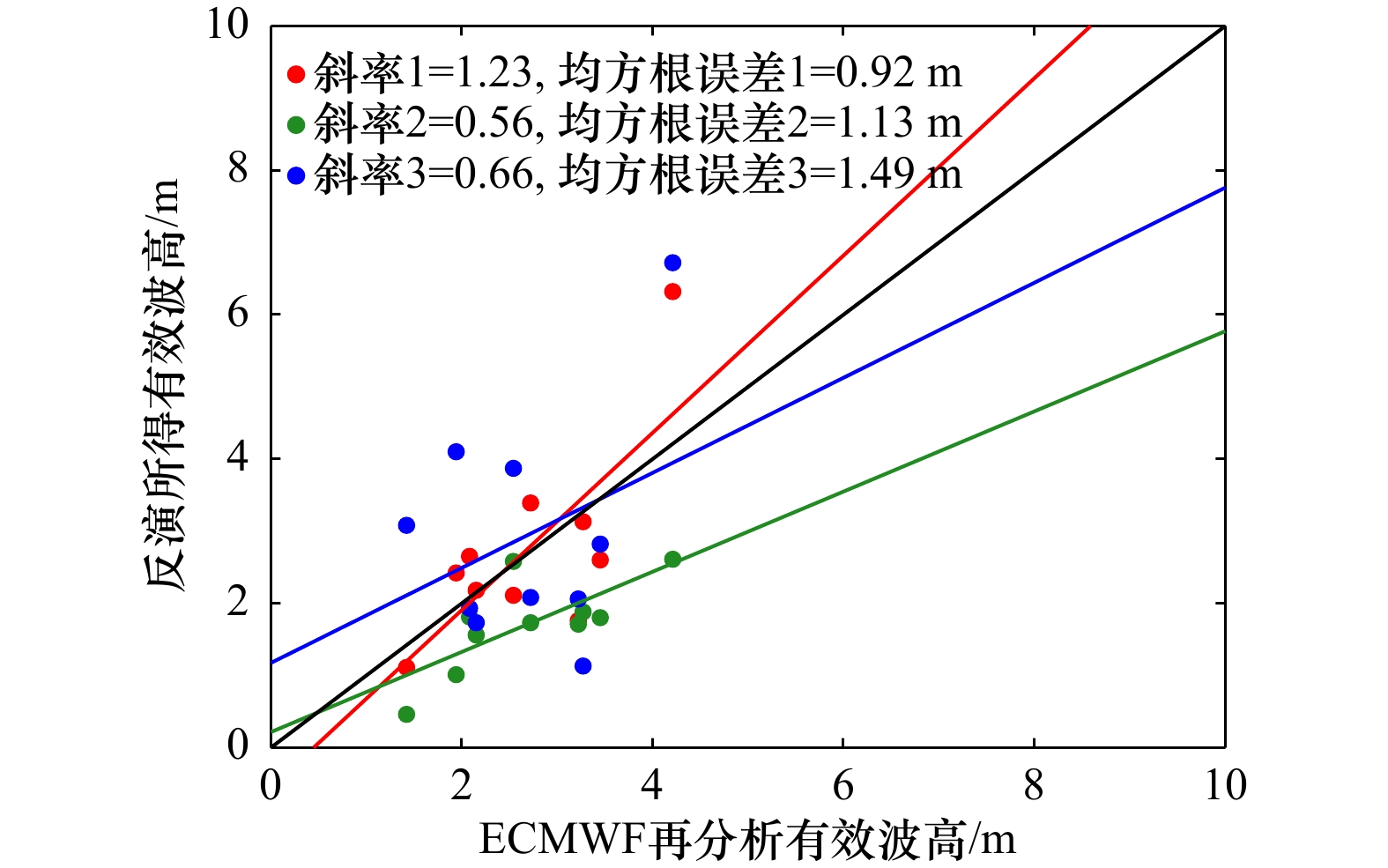Ocean wave inversion based on the velocity bunching modulation of SAR image
-
摘要: 本文首先对合成孔径雷达(SAR)海浪成像中的3种调制(倾斜调制、流体力学调制与速度聚束调制)的影响进行了对比分析,结果显示:速度聚束调制对SAR图像的影响最为显著。另外,由于SAR图像中固有相干斑噪声的存在,较低波数范围的噪声难以滤除或抑制,利用经典MPI方法反演海浪谱会造成低波数范围谱值偏大。基于此,本文借鉴经典MPI海浪谱反演算法,建立了基于速度聚束调制的海浪方位向斜率谱和有效波高的反演算法。通过将经典MPI方法、同极化调制法及本文算法等3种海浪反演方法所得有效波高与浮标数据进行比较,结果显示:本文方法反演得到的海浪有效波高与浮标数据获得的有效波高之间的均方误差为0.79 m,为3种方法中最小。Abstract: The effects of three kinds of modulation (the tilt modulation, the hydrodynamic modulation and the velocity bunching modulation) on sea wave SAR (synthetic aperture radar) image are compared and analyzed firstly. The results show that the velocity bunching modulation has the most significant effect on SAR images. In addition, due to the inherent speckle noise in the SAR image, it is difficult to filter or suppress the noise in the range of low wavenumber. And the inversion of wave spectrum by classical MPI (max-planck institute) method will result in the larger spectral value in the range of low wavenumber. Referring to the classical MPI inversion algorithm, an azimuth slope spectrum and SWH (significant wave height) inversion algorithm based on the velocity bunching modulation are proposed in this paper. Comparing the SWH obtained by the classical MPI method, the co-polarization modulation method and the algorithm proposed in this paper with the buoy data, one can find that the mean square error between the SWH retrieved by the algorithm proposed in this paper and the SWH obtained from buoy data is 0.79 m, which is the smallest among the three methods.
-
图 2 仿真海面SAR图像谱(a),仅考虑速度聚束调制的仿真海面SAR图像谱(b)和仅考虑倾斜调制和流体力学调制的仿真海面SAR图像谱(c)
Fig. 2 The spectrum of the simulated SAR image of sea surface (a), the spectrum of the simulated SAR image of sea surface with the velocity bunching modulation (b) and the spectrum of the simulated SAR image of sea surface with the tilt modulation and the hydrodynamic modulation (c)
图 4 Radarsat-2数据2中选取的512×512像素SAR图像(a),仅考虑速度聚束调制的SAR图像(b)和仅考虑倾斜调制和流体力学调制的SAR图像(c)
Fig. 4 SAR image of 512×512 size selected in Radarsat-2 data 2 (a), SAR image that only the velocity bunching modulation is considered (b) and SAR image that only the tilt modulation and the hydrodynamic modulation are considered (c)
图 5 SAR图像谱(a),仅考虑速度聚束调制的SAR图像谱(b)和仅考虑倾斜调制和流体力学调制的SAR图像谱(c)
Fig. 5 The spectrum of the SAR image (a), the spectrum of the SAR image that only the velocity bunching modulation is considered (b) and the spectrum of the SAR image that only the tilt modulation and the hydrodynamic modulation are considered (c)
图 6 仿真SAR图像谱积分能量随涌浪传播方向角的变化(a),在不同传播方向角下,考虑不同调制的谱积分能量占总能量的比重(b)
Fig. 6 The spectral integration value variation of the simulated SAR images with different wave propagation direction angle (a), the proportion of the spectral integration variation under the different modulation conditions with different wave propagation direction angles (b)
表 1 Radarsat-2全极化SAR数据信息
Tab. 1 Radarsat-2 full polarized SAR data information
数据序号 数据名 成像时间 中心坐标 1 RS2_OK105124_PK912453_DK845008_FQ4
_20090111_022504_HH_VV_HV_VH_SLC2009年1月11日
02:25:0446°04′06″N,
131°02′22″W2 RS2_OK105124_PK912454_DK845009_FQ18
_20090118_143058_HH_VV_HV_VH_SLC2009年1月18日
14:30:5845°57′43″N,
125°39′18″W3 RS2_OK105124_PK912455_DK845010_FQ20
_20090225_020926_HH_VV_HV_VH_SLC2009年2月25日
02:09:2635°44′43″N,
121°55′42″W4 RS2_OK105124_PK912456_DK845011_FQ12
_20090228_054758_HH_VV_HV_VH_SLC2009年2月28日
05:47:5851°07′18″N,
178°53′10″W5 RS2_OK105124_PK912457_DK845012_FQ4
_20090317_143915_HH_VV_HV_VH_SLC2009年3月17日
14:39:1546°07′05″N,
124°33′25″W6 RS2_OK105124_PK912458_DK845013_FQ13
_20090822_143105_HH_VV_HV_VH_SLC2009年8月22日
14:31:0546°08′05″N,
124°30′15″W7 RS2_OK29804_PK294773_DK265292_FQ10
_20100515_115636_HH_VV_HV_VH_SLC2010年5月15日
11:56:3628°33'05"N,
88°18'34″W8 RS2_OK92533_PK818353_DK746868_FQ1
_20091107_152316_HH_VV_HV_VH_SLC2009年11月7日
15:23:1654°21'23"N,
132°23'09"W9 RS2_OK92533_PK818354_DK746869_FQ12
_20091208_151913_HH_VV_HV_VH_SLC2009年12月8日
15:19:1354°11'19″N,
134°22'30″W10 RS2_OK100982_PK877033_DK810385_FQ17
_20170319_042844_HH_VV_HV_VH_SLC2017年3月19日
04:28:4454°01'02″N,
160°47'01″W表 2 Radarsat-2数据不同反演方法的有效波高结果
Tab. 2 The retrieved significant wave height of different inversion methods for Radarsat-2 data
数据序号 本文算法/m MPI法/m 同极化调制函数法/m 浮标实测/m ECMWF再分析数据/m 1 1.76 1.71 2.06 3.10 3.22 2 3.39 1.73 2.08 2.51 2.72 3 2.18 1.56 1.73 2.88 2.15 4 3.13 1.88 1.13 4.05 3.27 5 2.60 1.80 2.82 3.44 3.45 6 2.65 1.81 1.93 2.47 2.08 7 1.11 0.46 3.08 1.49 1.42 8 6.32 2.61 6.72 5.20 4.21 9 2.11 2.58 3.87 2.60 2.54 10 2.42 1.01 4.10 2.31 1.94 -
[1] Alpers W R, Ross D B, Rufenach C L. On the detectability of ocean surface waves by real and synthetic aperture radar[J]. Journal of Geophysical Research: Oceans, 1981, 86(C7): 6481−6498. doi: 10.1029/JC086iC07p06481 [2] Hasselmann K, Raney R K, Plant W J, et al. Theory of synthetic aperture radar ocean imaging: A MARSEN view[J]. Journal of Geophysical Research: Oceans, 1985, 90(C3): 4659−4686. doi: 10.1029/JC090iC03p04659 [3] Lyzenga D R, Shuchman R A, Lyden J D, et al. SAR imaging of waves in water and ice: Evidence for velocity bunching[J]. Journal of Geophysical Research: Oceans, 1985, 90(C1): 1031−1036. doi: 10.1029/JC090iC01p01031 [4] Alpers W, Rufenach C. The effect of orbital motions on synthetic aperture radar imagery of ocean waves[J]. IEEE Transactions on Antennas and Propagation, 1979, 27(5): 685−690. doi: 10.1109/TAP.1979.1142163 [5] Engen G, Johnsen H, Krogstad H E, et al. Directional wave spectra by inversion of ERS-1 synthetic aperture radar ocean imagery[J]. IEEE Transactions on Geoscience and Remote Sensing, 1994, 32(2): 340−352. doi: 10.1109/36.295049 [6] Jacobsen S, Høgda K A. Estimation of the real aperture radar modulation transfer function directly from synthetic aperture radar ocean wave image spectra without a priori knowledge of the ocean wave height spectrum[J]. Journal of Geophysical Research: Oceans, 1994, 99(C7): 14291−14302. doi: 10.1029/94JC00633 [7] Brüning C. The impact of the ocean wave-radar modulation transfer function on the inversion of ERS-1 SAR image spectra into ocean wave spectra[C]//Proceedings of IGARSS ’94−1994 IEEE International Geoscience and Remote Sensing Symposium. Pasadena, CA, USA: IEEE, 1994: 2032−2034. [8] Alpers W, Schmidt A, Schmidt R, et al. A comparison of ocean wave-radar modulation transfer functions at different radar frequencies and polarizations determined from tower and aircraft measurements[C]//1995 International Geoscience and Remote Sensing Symposium, IGARSS '95. Quantitative Remote Sensing for Science and Applications. Firenze, Italy: IEEE, 1995: 1087−1089. [9] Hasselmann K, Hasselmann S. On the nonlinear mapping of an ocean wave spectrum into a synthetic aperture radar image spectrum and its inversion[J]. Journal of Geophysical Research: Oceans, 1991, 96(C6): 10713−10729. doi: 10.1029/91JC00302 [10] Brüning C, Schmidt R, Alpers W. Estimation of the ocean wave-radar modulation transfer function from synthetic aperture radar imagery[J]. Journal of Geophysical Research: Oceans, 1994, 99(C5): 9803−9815. doi: 10.1029/93JC03373 [11] Hasselmann S, Brüning C, Hasselmann K, et al. An improved algorithm for the retrieval of ocean wave spectra from synthetic aperture radar image spectra[J]. Journal of Geophysical Research: Oceans, 1996, 101(C7): 16615−16629. doi: 10.1029/96JC00798 [12] Mastenbroek C, De Valk C F. A semiparametric algorithm to retrieve ocean wave spectra from synthetic aperture radar[J]. Journal of Geophysical Research: Oceans, 2000, 105(C2): 3497−3516. doi: 10.1029/1999JC900282 [13] Schulz-Stellenfleth J, Lehner S, Hoja D. A parametric scheme for the retrieval of two-dimensional ocean wave spectra from synthetic aperture radar look cross spectra[J]. Journal of Geophysical Research: Oceans, 2005, 110(C5): C05004. [14] Zhang Biao, Perrie W, He Yijun. Validation of RADARSAT-2 fully polarimetric SAR measurements of ocean surface waves[J]. Journal of Geophysical Research: Oceans, 2010, 115(C6): C06031. [15] He Yijun, Perrie W, Xie Tao, et al. Ocean wave spectra from a linear polarimetric SAR[J]. IEEE Transactions on Geoscience and Remote Sensing, 2004, 42(11): 2623−2631. doi: 10.1109/TGRS.2004.836813 [16] He Yijun, Shen Hui, Perrie W. Remote sensing of ocean waves by polarimetric SAR[J]. Journal of Atmospheric and Oceanic Technology, 2006, 23(12): 1768−1773. doi: 10.1175/JTECH1948.1 [17] Schulz-Stellenfleth J, König T, Lehner S. An empirical approach for the retrieval of integral ocean wave parameters from synthetic aperture radar data[J]. Journal of Geophysical Research: Oceans, 2007, 112(C3): C03019. [18] Li Xiaoming, Lehner S, Bruns T. Ocean wave integral parameter measurements using Envisat ASAR wave mode data[J]. IEEE Transactions on Geoscience and Remote Sensing, 2011, 49(1): 155−174. doi: 10.1109/TGRS.2010.2052364 [19] Stopa J E, Mouche A. Significant wave heights from Sentinel-1 SAR: Validation and applications[J]. Journal of Geophysical Research: Oceans, 2017, 122(3): 1827-1848. [20] Pleskachevsky A L, Rosenthal W, Lehner S. Meteo-marine parameters for highly variable environment in coastal regions from satellite radar images[J]. ISPRS Journal of Photogrammetry and Remote Sensing, 2016, 119: 464−484. doi: 10.1016/j.isprsjprs.2016.02.001 [21] Romeiser R, Graber H C, Caruso M J, et al. A new approach to ocean wave parameter estimates from C-band scanSAR images[J]. IEEE Transactions on Geoscience and Remote Sensing, 2015, 53(3): 1320−1345. doi: 10.1109/TGRS.2014.2337663 [22] Shao Weizeng, Zhang Zheng, Li Xiaofeng, et al. Ocean wave parameters retrieval from Sentinel-1 SAR imagery[J]. Remote Sensing, 2016, 8(9): 707. doi: 10.3390/rs8090707 [23] Grieco G, Lin Wenming, Migliaccio M, et al. Dependency of the Sentinel-1 azimuth wavelength cut-off on significant wave height and wind speed[J]. International Journal of Remote Sensing, 2016, 37(21): 5086−5104. doi: 10.1080/01431161.2016.1226525 [24] Shao Weizeng, Jiang Xingwei, Nunziata F, et al. Analysis of waves observed by synthetic aperture radar across ocean fronts[J]. Ocean Dynamics, 2020, 70(11): 1397−1407. doi: 10.1007/s10236-020-01403-2 [25] Shao Weizeng, Hu Y Y, Zheng G, et al. Sea state parameters retrieval from cross-polarization Gaofen-3 SAR data[J]. Advances in Space Research, 2020, 65(3): 1025−1034. doi: 10.1016/j.asr.2019.10.034 [26] Wright J. A new model for sea clutter[J]. IEEE Transactions on Antennas and Propagation, 1968, 16(2): 217−223. doi: 10.1109/TAP.1968.1139147 [27] Lyzenga D R. Numerical simulation of synthetic aperture radar image spectra for ocean waves[J]. IEEE Transactions on Geoscience and Remote Sensing, 1986, GE-24(6): 863−872. doi: 10.1109/TGRS.1986.289701 [28] Keller W C, Wright J W. Microwave scattering and the straining of wind-generated waves[J]. Radio Science, 1975, 10(2): 139−147. doi: 10.1029/RS010i002p00139 [29] Arsenault H H, April G. Properties of speckle integrated with a finite aperture and logarithmically transformed[J]. Journal of the Optical Society of America, 1976, 66(11): 1160−1163. doi: 10.1364/JOSA.66.001160 [30] Lee J S. Speckle analysis and smoothing of synthetic aperture radar images[J]. Computer Graphics and Image Processing, 1981, 17(1): 24−32. doi: 10.1016/S0146-664X(81)80005-6 [31] Lee J S. Speckle suppression and analysis for synthetic aperture radar images[J]. Optical Engineering, 1986, 25(5): 636−646. doi: 10.1117/12.7973877 [32] Lee J S, Jurkevich L, Dewaele P, et al. Speckle filtering of synthetic aperture radar images: A review[J]. Remote Sensing Reviews, 1994, 8(4): 313−340. doi: 10.1080/02757259409532206 -





 下载:
下载:











